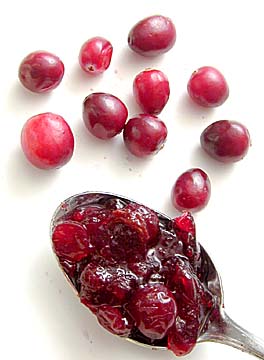

Key Ingredient

KEY INGREDIENT: CRANBERRIES
The holidays and cranberries have always gone hand in hand. Legend has it the Pilgrims served cranberries at the first Thanksgiving, thus the fruit's intimate tie to the holidays.
Canned and dried cranberries are available year-round, but now is the time to enjoy them fresh.
The basics: Cranberries are the berries of a trailing vine grown on large, sandy bogs. Originally called craneberries because of the blossom's resemblance to cranes, cranberries are one of only a handful of fruits native to North America. American Indians believed they had strong medicinal value, and today cranberry juice is widely known for preventing urinary tract infections.
Fresh cranberries are high in vitamin C.
Selecting: Fresh cranberries generally come in 12-ounce bags. Make sure berries are shiny and plump, not shriveled.
Storing: Fresh cranberries store well in the refrigerator and can be kept about a month. They can also be frozen directly in their plastic bags for up to one year.
Use: Wash berries and pick out any bits of leaves or twigs. Because of their extreme tartness, cranberries should be combined with other fruits, such as apples and oranges, and cooked down with water and sugar.
Cranberries contain pectin (a carbohydrate-based natural gelatinous substance), which makes them ideal for use in conserves and sauces.
Try using this versatile fruit in a glaze for ham or roast chicken, in stuffings or salsas and fruity cobblers or tarts.
Where to buy: Cranberries are available in most markets from October through December, selling for $2.49 to $3.69 for 12 ounces.
Food Stuffs: Morsels
Contact Eleanor Nakama-Mitsunaga
online through features@starbulletin.com